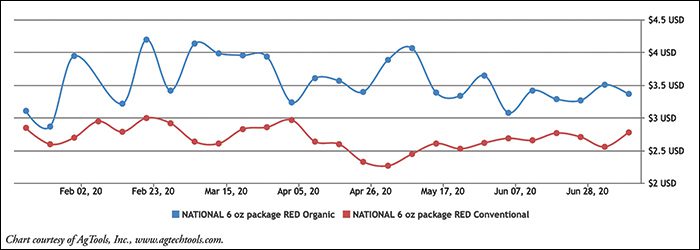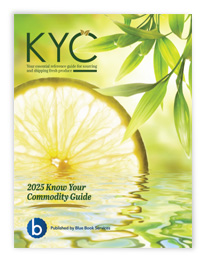Raspberry & Blackberry Market Summary

Image: Valentina Proskurina/Shutterstock.com
Raspberry & Blackberry Market Overview
Raspberries and blackberries, known as “brambles” or caneberries because they grow on stiff canes, are both members of the rose family. Botanically speaking they are not berries but aggregate fruits, comprised of drupelets formed from multiple ovaries within the same flower. Raspberries and blackberries have been grown throughout the ages as a valuable food source and for medicinal purposes. Both can be found around the globe, but it is believed Asia may have been the birthplace of the highly perishable fruits, particularly red raspberries. English growers popularized both raspberries and blackberries by the 1600s and brought cultivars to America, though the fruit was already growing in North America. Red raspberries may originally have been introduced by prehistoric peoples; black raspberries and blackberries are thought to be native to North America and other parts of the world. Although many states grow raspberries and/or blackberries, California, Oregon, and Washington contribute the lion’s share of supply for both fresh and processing volume. California dominates production in red and black raspberry varieties for the fresh market; Washington tops production for red raspberries destined for freezing or processing. Growers in cooler climates generally grow raspberries, while blackberry production has risen in the Southeast in recent years. British Columbia is a significant producer of raspberries for Canada; the True North is also the top export destination for U.S. fresh raspberry shipments. Imported raspberries and blackberries principally come from Mexico. Raspberries are also widely cultivated in Russia and throughout Europe.
Types & Varieties of Raspberries & Blackberries
Brambles are grown as either fall-bearing (primocane) or summer-bearing (floricane) varieties. Fall-bearing plants can produce berries in their first year; summer-bearing do not bear fruit until their second year. Newer primocane varieties of blackberries can produce summer crops, fall crops, or both. Use of thornless cultivars is especially desired for the fresh market due to harvesting by hand. Increased use of high tunnels is now prolonging the season and harvest window for both fruits. Raspberries are primarily available in red and black varieties, though purple (a cross between red and black varieties) and yellow (a mutation of red cultivars) can be found as well. One of the earliest varieties was Latham; subsequent cultivars included Meeker and Willamette, followed by many others. Among the popular hybrids are Tulameen, Heritage, Algonquin, Allen, Brandywine, Bristol, Coho, Caroline, Cowichan, Killarney, Kiwigold, Malahat, Saanich, Summit, and Titan. Major commercial blackberry varieties for the U.S. fresh market include Apache, Chester, Natchez, Navaho, Osage, Ouachita, Prime-Ark 45, and Triple Crown, but there are many other proprietary varieties, like Ponca, an early season berry from the University of Arkansas. Tupy is the most common variety grown in Mexico for winter export, while Marion and Columbia Star are common in the Pacific Northwest (although most Pacific Northwest berries go for processing and Marion is too soft for the fresh market).Cultivation of Raspberries & Blackberries
Raspberries and blackberries should be grown in full sun and prefer rich, well-drained, sandy-loam soil that is slightly acidic. Adequate insect pollination is required to prevent underdeveloped fruit with few drupelets.Pests & Diseases Affecting Raspberries & Blackberries
Both berries are susceptible to numerous pests including aphids, armyworms, beetles, caterpillars, earwigs, loopers, lygus bugs, nematodes, raspberry crown borers, root weevils, sawflies, slugs, spider mites, and stinkbugs. Various diseases can affect berries during the growing season, including multiple types of blight, canker, mold, rust, and rot, as well as anthracnose, leaf curl, mosaic virus, powdery mildew, sunscald, and verticillium wilt. Wet weather is the perfect breeding ground for many diseases, especially mold. Though it begins in the growing area, improper handling and temperature may spread the disease during transit and storage. Prompt precooling and temperature management will help control the disease. Additionally, both berries can be affected by white drupelet syndrome, where sunscald or pest damage causes some of the drupelets to be white. Red cell disorder affects blackberries in refrigerated storage, causing drupelets to revert back to the unripe reddish color. These physiological problems affect the appearance, but not the flavor, healthfulness, or shelf life of the fruit. A particularly potent and more recent problem is spotted wing drosophila, which lays eggs in ripening berries. Larvae then damage drupelets and can lead to rot. Redberry mites can cause blackberry drupelets to stay a bright red rather than developing to their normal coloring.
Storage & Packaging of Raspberries & Blackberries
Raspberries are among the most perishable of produce commodities, requiring expedited delivery and stringent temperature control for shipping. Blackberries, too, are highly perishable, but since drupelets are attached to core tissue, they are less tender than raspberries. Under ideal circumstances, shelf life for raspberries rarely exceeds a few days. Both berries can lose moisture and respire quickly, though blackberries have a longer shelf life if temperatures are properly maintained (up to a week or more). Optimal handling and shipping temperature is 32°F and 90 to 95% percent relative humidity. Higher temperatures will cause softening and decay, while lower temperatures can lead to freezing injury. If exposed to overly cold temperatures, affected fruit will appear dull and translucent, with berries becoming soft and leaky when reaching room temperature. Similar damage can also be caused by rough handling. Berries located directly over the wheels of trucks with poor suspension can exhibit such damage. Berries wrapped in plastic with modified atmosphere can provide additional protection against decay and ripening during transit. Packing should allow adequate space as well as venting for air circulation to prevent undue pressure on drupelets, which can cause juice loss. References: California State Polytechnic University, Cornell University Cooperation Extension, North American Raspberry & Blackberry Association, Oregon State University, PennState Extension, University of Arkansas Research & Extension, USDA, Washington Red Raspberry Commission, Washington State University.Grades & Good Arrival of Raspberries & Blackberries
High quality raspberries and blackberries are well colored and well developed; of regular shape; appear turgid; and are free of injury, mold, decay, and sunscald. Maturity can be determined by fruit color, gloss, and ease of detachment. Fully ripe blackberries should pull easily from the pedicel yet be firm, not mushy. Blackberries lose acidity with ripening and are quite astringent if harvested with partial color. Raspberries should be unbroken and free from cores, and blackberries free from caps (calyxes).Raspberries
| U.S. Grade Standards | Days Since Shipment | % of Defects Allowed | Optimum Transit Temp. (°F) |
| 10-5-1 | 5 4 3 2 1 | 15-8-3 14-8-3 13-7-2 11-6-1 10-6-1 | 32° |
Blackberries
| U.S. Grade Standards | Days Since Shipment | % of Defects Allowed | Optimum Transit Temp. (°F) |
| 10-5-1 | 5 4 3 2 1 | 15-8-3 14-8-3 13-7-2 11-6-1 10-6-1 | 31-32° |


